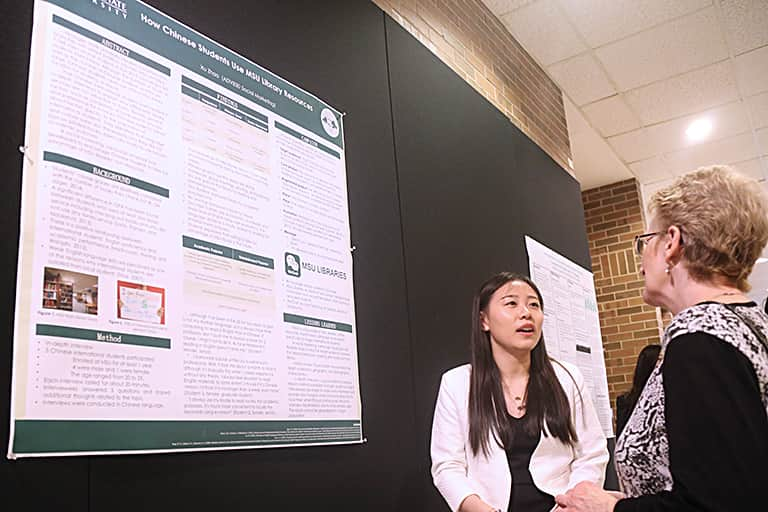On April 29 at the AD + PR & MI Research and Arts Poster Forum, 21 graduate students in Advertising and Media and Information presented research or work from internships completed during their master's programs. The participants included 19 Advertising students and two studying Media and Information.
All graduate students are required to develop a final project by the end of their program. There are several options available to them, such as a written thesis, referred to as Plan A. Students can also choose to present research or an internship at the Poster Forum at the end of the year, called Plan B.
"Students really like this experience even though it's kind of stressful to them," said Linda Good, Director of Graduate Studies in the Department of Advertising, Public Relations and Retailing. "They really feel like it's a way to culminate the end of the two years or year and a half that they've spent in graduate school, so we're very pleased with the way things turned out."
The posters are judged by faculty and doctoral students who critique each submission based on the content, organization and delivery.
This year's winner for the Top Research Poster was Xueyiting Li. Her research studied "how cultural dimensions affect the clicking behaviors of consumers when shopping online." She began the research during an independent study with Assistant Professor Anastasia Kononova.
"As an international student, I felt the cultural differences when I came here two years ago," she said. "I became interested in cross-culture studies in advertising, consumer behaviors. I think it is critical for companies to consider culture as an important factor when they enter (a) new market."
Other winners were Dan Hesselschwerdt who received the award for the Best MA MI Poster Award; Tyler Hoover won first place for his Internship Poster; and Jian Bao who was awarded second place in the Internship Poster category.
Hoover's poster reflected research he gathered during his internship with MSU Football. In his position, Hoover said that he worked with the graphic design team creating designs and images for social media. His poster demonstrated how social media can impact the online success of sport coaches.
"What I wanted to do is just be able to compare each coach's success on Twitter and, basically, the graphic design success. So, how I measured it was by tweets and then likes, retweets, replies and then, if you put all those together you follow the engagement," he said. "I measured the engagement of each specific coach's Twitter handle."
His results pinpointed a correlation between the most popular tweets and the content produced by him and the rest of the graphic design team.
"At the end of the semester, we realized that the graphic designs that we created were actually the top tweet for every coach. So, it was pretty significant," he said.
Hoover enjoyed the Poster Forum and said that he admired the efforts of fellow graduate student participants, "It was really interesting to see the rest of the class's work and see what they've been doing throughout the semester. You kind of gain some respect for everyone just because when you're in two or three grad classes and doing an internship and doing the poster project, it gets pretty busy."
Li saw the Poster Forum as a unique way for master's students to showcase and discuss their findings.
"I could feel how excited everyone is when they talk with the faculties about their experiences," she said. "I feel very happy when people are interested in my study and give me good further advice."
